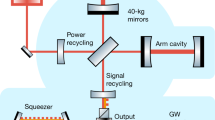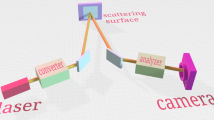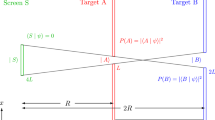Abstract
Five decades ago, Hanbury Brown and Twiss (HBT) demonstrated that the angular size of stars can be measured by correlating the intensity fluctuations measured by two detectors at two different locations. Since then, non-local correlation measurements have become ubiquitous in many areas of physics and have also been applied, beyond photons, to electrons, matter waves and subatomic particles. An important assumption in HBT interferometry is that the particles do not interact on their way from the source to the detectors. However, this assumption is not always valid. Here, we study the effects of interactions on HBT interferometry by considering the propagation of light fields in a nonlinear medium that induces interactions between the photons. We show that interactions affect multipath interference, limiting the ability to extract information on the source. Nevertheless, we find that proper analysis of the intensity fluctuations can recover the size of the source, even in the presence of interactions.
This is a preview of subscription content, access via your institution
Access options
Subscribe to this journal
Receive 12 print issues and online access
$209.00 per year
only $17.42 per issue
Buy this article
- Purchase on Springer Link
- Instant access to full article PDF
Prices may be subject to local taxes which are calculated during checkout



Similar content being viewed by others
References
Hanbury Brown, R. &. Twiss, R. Q. A test of a new type of stellar interferometer on Sirius. Nature 178, 1046–1048 (1956).
Hanbury Brown, R. &. Twiss, R. Q. Correlations between photons in two coherent beams of light. Nature 177, 27–29 (1956).
Hanbury Brown, R. The Intensity Interferometer: Its Application to Astronomy (Taylor & Francis, 1974).
Glauber, R. G. Photon correlations. Phys. Rev. Lett. 10, 84–86 (1963).
Fano, U. Quantum theory of interference effects in the mixing of light from phase independent sources. Am. J. Phys. 29, 539–545 (1961).
Baym, G. The physics of Hanbury Brown–Twiss intensity interferometry: from stars to nuclear collisions. Acta. Phys. Pol. B 29, 1839–1884 (1998).
Altman, E., Demler, E. & Lukin, M. D. Probing many body correlations of ultra-cold atoms via noise correlations. Phys. Rev. A 70, 013603 (2004).
Polkovnikov, A., Altman, E. & Demler, E. Interference between independent fluctuating condensates. Proc. Natl Acad. Sci. USA 103, 6125–6129 (2006).
Schellekens, M. et al. Hanbury Brown Twiss effect for ultracold quantum gases. Science 310, 648–651 (2005).
Fölling, S. et al. Spatial quantum noise interferometry in expanding ultracold atom clouds. Nature 434, 481–484 (2005).
Büttiker, M. Scattering theory of thermal and excess noise in open conductors. Phys. Rev. Lett. 65, 2901–2904 (1990).
Martin, T. & Landauer, R. Wave-packet approach to noise in multichannel mesoscopic systems. Phys. Rev. B 45, 1742–1755 (1992).
Samuelsson, P., Sukhorukov, E. V. & Büttiker, M. Two-particle Aharonov–Bohm effect and entanglement in the electronic Hanbury Brown–Twiss setup. Phys. Rev. Lett. 92, 026805 (2004).
Oliver, W. D., Kim, J., Liu J. & Yamamoto, Y. Hanbury Brown and Twiss-type experiment with electrons. Science 284, 299–301 (1999).
Henny, M. et al. The fermionic Hanbury Brown and Twiss experiment. Science 284, 296–298 (1999).
Neder, I. et al. Interference between two indistinguishable electrons from independent sources. Nature 448, 333–337 (2007).
Kiesel, H., Renz, A. & Hasselbach, F. Observation of Hanbury Brown–Twiss anticorrelations for free electrons. Nature 418, 392–394 (2002).
Rom, T. et al. Free fermion antibunching in a degenerate atomic Fermi gas released from an optical lattice. Nature 444, 733–736 (2006).
Jeltes, T. et al. Comparison of the Hanbury Brown–Twiss effect for bosons and fermions. Nature 445, 402–405 (2007).
Lobo, C. & Gensemer, S. D. Techniques for measuring correlation functions in interacting gases. Phys. Rev. A 78, 023618 (2008).
Goodman, J. W. Speckle Phenomena in Optics (Roberts & Co., 2007)
Boitier, F., Godard, A., Rosencher, E. & Fabre, C. Measuring photon bunching at ultrashort timescale by two-photon absorption in semiconductors. Nature Phys. 5, 267–270 (2009).
Pethick, C. J. & Smith, H. Bose–Einstein Condensation in Dilute Gases (Cambridge Univ. Press, 2002).
Mitchell, M. & Segev, M. Self-trapping of incoherent white light. Nature 387, 880–883 (1997).
Rotschild, C., Schwartz, T., Cohen, O. & Segev, M. Incoherent spatial solitons in effectively instantaneous nonlinear media. Nature Photon. 2, 371–376 (2008).
Levi, L., Schwartz, T., Manela, O., Segev, M. & Buljan, H. Spontaneous pattern formation upon incoherent waves: from modulation-instability to steady-state. Opt. Express 16, 7818–7831 (2008).
Picozzi, A. Towards a nonequilibrium thermodynamic description of incoherent nonlinear optics. Opt. Express 15, 9063–9083 (2007).
Aitchison, J. S. et al. Spatial optical solitons in planar glass waveguides. J. Opt. Soc. Am. B 8, 1290–1297 (1991).
Martienssen, W. & Spiller, E. Coherence and fluctuations in light beams. Am. J. Phys. 32, 919–926 (1964).
Rieckhoff, K. E. Self-induced divergence of CW laser beams in liquids—a new nonlinear effect in the propagation of light. Appl. Phys. Lett. 9, 87–88 (1966).
Trillo, S. & Torruellas, W. E. Spatial Solitons (Springer-Verlag, 2001).
Stegeman, G. I. & Segev, M. Optical spatial solitons and their interactions: universality and diversity. Science 286, 1518–1523 (1999).
Weiner, A. M. et al. Experimental observation of the fundamental dark soliton in optical fibers. Phys. Rev. Lett. 61, 2445–2448 (1988).
Swartzlander, G. A. Jr, Andersen, D. R., Regan, J. J., Yin, H. & Kaplan, A. E. Spatial dark-soliton stripes and grids in self-defocusing materials. Phys. Rev. Lett. 66, 1583–1586 (1991).
Kivshar, Y. S. & Luther-Davies, B. Dark optical solitons: physics and applications. Phys. Rep. 298, 81–197 (1998).
Silberberg, Y. Collapse of optical pulses. Opt. Lett. 15, 1282–1284 (1990).
Franson, J. D. Bell inequality for position and time. Phys. Rev. Lett. 62, 2205–2208 (1989).
Yurke, B. & Stoler, D. Bell's-inequality experiments using independent-particle sources. Phys. Rev. A 46, 2229–2234 (1992).
Samuelsson, P., Neder, I. & Büttiker, M. Reduced and projected two-particle entanglement at finite temperatures. Phys. Rev. Lett. 102, 106804 (2009).
Neder, I., Heiblum, M., Levinson, Y., Mahalu, D. & Umansky, V. Unexpected behaviour in a two-path electron interferometer. Phys. Rev. Lett. 96, 016804 (2006).
Kimble, H. J., Dagenais, M. & Mandel, L. Photon antibunching in resonance fluorescence. Phys. Rev. Lett. 39, 691–695 (1977).
Tian, L. & Carmichael, H. J. Quantum trajectory simulations of two-state behaviour in an optical cavity containing one atom. Phys. Rev. A 46, R6801–R6804 (1992).
Rempe, G., Thompson, R. J., Brecha, R. J., Lee, W. D. & Kimble, H. J. Optical bistability and photon statistics in cavity quantum electrodynamics. Phys. Rev. Lett. 67, 1727–1730 (1991).
Mielke, S. L., Foster, G. T. & Orozco, L. A. Nonclassical intensity correlations in cavity QED. Phys. Rev. Lett. 80, 3948–3951 (1998).
Birnbaum, K. M. et al. Photon blockade in an optical cavity with one trapped atom. Nature 436, 87–90 (2005).
Kwiat, P. G. et al. New high-intensity source of polarization-entangled photon pairs. Phys. Rev. Lett. 75, 4337–4341 (1995).
Acknowledgements
The authors would like to thank A. Natan, O. Katz and M. Covo for invaluable help. Financial support by the Crown Centre of Photonics is gratefully acknowledged. Y.L. is supported by the Adams fellowship of the Israeli Academy of Science and Humanities.
Author information
Authors and Affiliations
Contributions
Y.B. and Y.L. designed and performed the experiment, analysed the data and prepared the manuscript. E.S. performed the experiment and analysed the data. Y.S. designed the experiment, analysed the data and prepared the manuscript.
Corresponding author
Ethics declarations
Competing interests
The authors declare no competing financial interests.
Supplementary information
Supplementary information
Supplementary information Figures and lengends (PDF 560 kb)
Supplementary information
Supplementary Movie (MOV 218 kb)
Supplementary information
Supplementary Movie (MOV 203 kb)
Supplementary information
Supplementary Movie (MOV 413 kb)
Supplementary information
Supplementary Movie (MOV 149 kb)
Supplementary information
Supplementary Movie (MOV 326 kb)
Rights and permissions
About this article
Cite this article
Bromberg, Y., Lahini, Y., Small, E. et al. Hanbury Brown and Twiss interferometry with interacting photons. Nature Photon 4, 721–726 (2010). https://doi.org/10.1038/nphoton.2010.195
Received:
Accepted:
Published:
Issue Date:
DOI: https://doi.org/10.1038/nphoton.2010.195
This article is cited by
-
Intensity correlation scan (IC-scan) technique to characterize the optical nonlinearities of scattering media
Scientific Reports (2023)
-
Observation of the modification of quantum statistics of plasmonic systems
Nature Communications (2021)
-
Optical quantum technologies with hexagonal boron nitride single photon sources
Scientific Reports (2021)
-
Diffraction based Hanbury Brown and Twiss interferometry at a hard x-ray free-electron laser
Scientific Reports (2018)
-
Observation of replica symmetry breaking in disordered nonlinear wave propagation
Nature Communications (2017)



